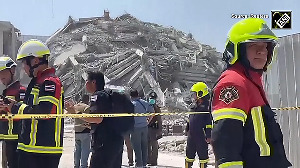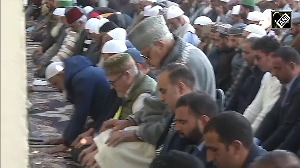'We carry 6.5 billion passengers every year. We have crossed seven billion this year, and are targeting 10 billion by 2030.'

The railways has been one of the focus areas of the government, especially in the wake of the capital expenditure-led push for growth after COVID-19.
However, there has been concern over the transporter's capacity for the poor.
The ministry of railways will spend Rs 14 trillion to increase passenger capacity to 10 billion to de-congest the passenger network, Union Railways Minister Ashwini Vaishnaw tells Surajeet Das Gupta and Dhruvaksh Saha/Business Standard.
What is the progress on becoming independent in the railway supply chain?
First, locomotives. Globally, 2,000 locomotives are produced per year, and India stands at 1,000. A large base of manufacturing is in India, through railway production units.
On many parameters, the Vande Bharat would be superior to well-established European brands -- on vibration, noise, riding quality, acceleration, etc.
So once we have a substantial amount in India, we will look at the export market.
Another segment in rolling stock is wagon manufacturing, in which we are strong.
We have Indianised these aspects. In the context of a global value chain, our domestic value addition is significantly large compared to, say, Europe.
The only missing piece was forged wheels, and we have created a capacity of roughly 230,000, while our demand is for 80,000-100,000. We'll become exporters in that segment too.
Do you see private-sector manufacturing in India's rolling stock reaching a level where one could see a competitor to European and other major rail firms coming from here?
I think India's production will be primarily from the production units (owned and operated by railways), but the supply chain behind that will grow significantly, and, as has been the case with electronics, many in the supply chain will become global supply hubs.
What will be the railways' focus?
We'll add about 3,000 million tonnes (mt) of cargo in seven-eight years, and are working to capture 1,500 mt from this incremental cargo.
We are adding close to 14 kilometres (km) of tracks every day. Infrastructure capacity is a big constraint. We have added about 26,000 km in the past year through doubling and multi-tracking.
On cargo, we are getting a new generation of rolling stock -- 9,000 horsepower locomotives, which have a reliability rate of 99.99 per cent, new-generation wagons, significantly improved maintenance practices, and investment in technology.
We carry 6.5 billion passengers every year. We have crossed seven billion this year, and are targeting 10 billion by 2030.
What kind of investments will be required for this?
In infrastructure, there will be common investments. In trainsets, Vande Metro will be used for short distances and Vande Bharat chair cars will be preferred for intermediate distances, and for longer distances, Vande Bharat sleeper class.
For the upgradation of the existing rolling stock, the Amrit Bharat trains with a push-pull configuration will be launched by the Prime Minister on December 30.
This will change the landscape of passenger travel in terms of safety through Kavach integration and riding experience.
Will this investment be made only to upgrade existing rolling stock?
We are increasing the passenger capacity to 10 billion. By 2030, waiting lists will not exist.
Infrastructure investment will be Rs 12 trillion, and investment in rolling stock close to Rs 2 trillion, mostly through the central government's Budget funds.
While these developments will be years down the line, how do you address the criticism that the railways was caught off guard in its estimation of general class passengers?
Incorrect criticism. We used to have a standard configuration of a train, and that has been maintained throughout.
A ratio of 2:1 was in use for passenger travel, where there will be two non-air-conditioned coaches for every air-conditioned coach, and it still is.
When there is so much capacity building and expansion work happening, for a temporary period, there will be disruption in service.
Last year, we added tracks of 5,200 km. When we are connecting these new tracks with the existing system, train service does get cancelled.
Since the railways is an ever continuous service, when there is a discontinuity, there is a sudden demand.
Some parties are politicising this, but the increase in capacity is giving people better service.
Punctuality in about seven divisions has reached 99 per cent.
Are you looking at raising fares and prices?
We have a social obligation. The railways is the most affordable mode of transport. It gives 55 per cent concession for rail travel, which is realised from our internal revenues.
Budgetary support comes for capital expenditure -- which has been the case for railways and highway development in many countries.
In 2020, a decision was made to remove non-AC coaches from trains running at speeds above 130 km per hour (KMPH). With more trains getting speed upgrades, should there be concern about the availability of non-AC coaches?
The concern would be unfounded. On the surface, it is prudent to have 130 kmph as a standard speed. Technically, if a train is moving as a segregated set of units, it becomes aerodynamically unstable.
Now, we have provided sealed gangways, semi-permanent couplers, and aerodynamically better trains with Amrit Bharat trains, which will be a safer train at higher speeds.
What is the future of expansion in the dedicated freight corridor?
We should look at the railways as a tightly integrated network.
For a system like ours, which has conventionally been a mixed traffic network, we should improve capacity in every section that has reached a saturation level and scale up the mobility of the complete network.
We have identified more than 600 sections that require doubling, multi-tracking, changing yard layouts, surface crossings, etc.
This has given us the wherewithal to become the second-largest freight-carrying rail network (surpassing the US) after adding 400 mt of cargo in the last nine years.
The upcoming expansion will help us reach 3000 mt.
What is the estimate of the railway network in the coming years?
It will cross 100,000 route km by 2030.
What is the progress on Mumbai-Ahmedabad high-speed rail?
It is impressive. We have crossed more than 270 km and are on track to inaugurate the first section by 2026. The first phase involved some changes to the design, keeping in mind India's climate.
Feature Presentation: Aslam Hunani/Rediff.com












 © 2025
© 2025